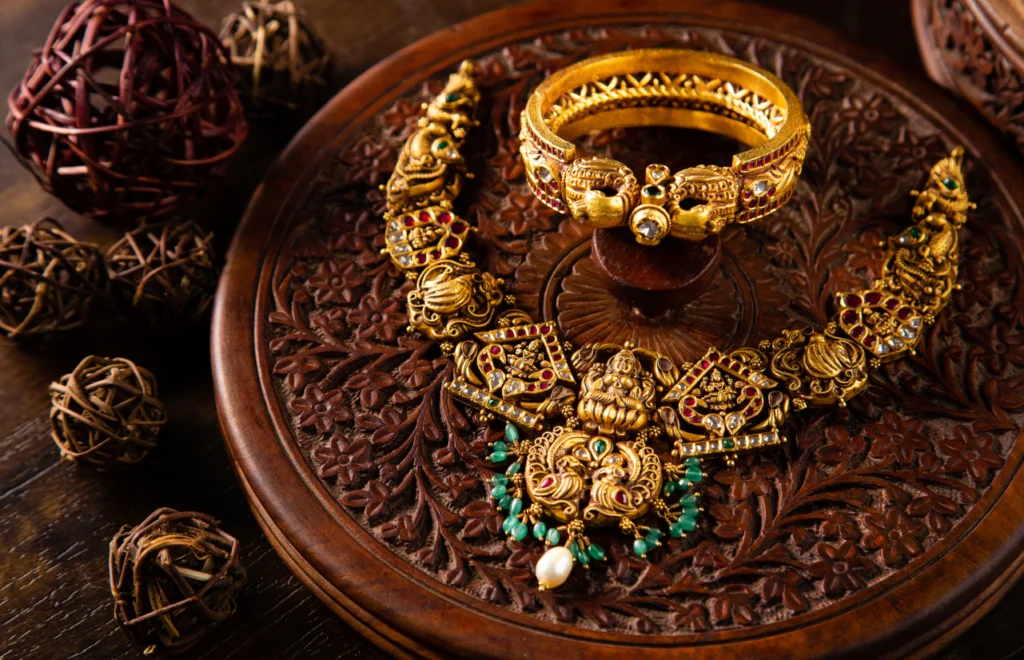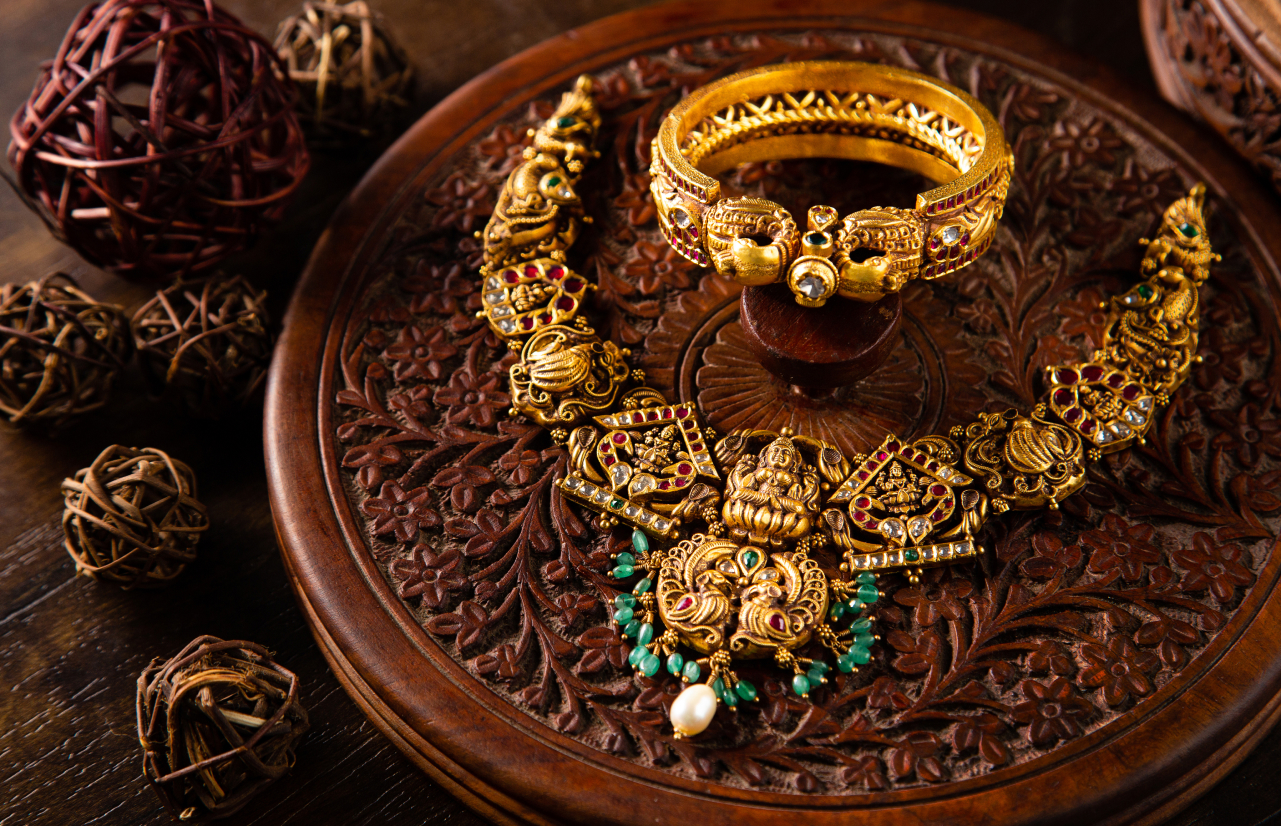In a world where fashion trends change every season, some styles withstand the test of time. One such timeless treasure is temple jewellery—an exquisite representation of India’s devotion and design. But what is temple jewellery, and why does it continue to captivate jewellery lovers across generations?
Let’s unravel the history, craftsmanship, and modern appeal of temple jewellery, and find out why it is a must-have in every Indian woman’s collection.

What Is Temple Jewellery?
Temple jewellery is a traditional form of South Indian jewellery that originated centuries ago in Tamil Nadu. It was initially created to adorn the idols of deities in temples, hence the name. Over time, these sacred ornaments became an integral part of classical dance costumes, bridal trousseaus, and heirloom collections.
Key Features of Temple Jewellery:
- Intricate craftsmanship
- Traditional motifs of gods, goddesses, elephants, peacocks, and floral patterns
- Typically made with gold, sometimes embellished with rubies, emeralds, and pearls
- Heavy and regal in appearance
A Brief History: Where Devotion Meets Design
The roots of temple jewellery go back to the Chola and Pandya dynasties. Skilled artisans of that era created elaborate gold ornaments for temple idols using ancient techniques like repoussé, granulation, and filigree.
As Bharatanatyam and Kuchipudi dancers began to mimic the divine look of idols, temple jewellery made its way from sanctums to stages. It was no longer just about devotion but a celebration of India’s artistic legacy.
“Each piece of temple jewellery is a miniature sculpture that echoes centuries of cultural pride and spiritual reverence.”
What Is Temple Gold Jewellery?
When we talk about temple gold jewellery, we refer to pieces crafted in pure or high-carat gold, traditionally handmade. These designs are:
- Grand and statement-worthy
- Often passed down as heirlooms
- Used in weddings, religious ceremonies, and classical performances
Gold temple jewellery is a symbol of wealth, tradition, and divine blessings. The use of uncut rubies (kemp stones), antique finishing, and detailed godly motifs make it distinguishable from other gold ornaments.
What’s the Difference Between Temple Jewellery and Antique Jewellery?
This is a common question for jewellery lovers: What’s the difference between temple jewellery and antique jewellery?
| Feature | Temple Jewellery | Antique Jewellery |
|---|---|---|
| Origin | Rooted in temple traditions of South India | Can be from various historical eras like Victorian, Mughal, Art Deco |
| Inspiration | Depictions of Indian deities and mythology | Varies from Indian royal courts to Western influences |
| Motifs | Lakshmi, Ganesha, elephants, lotus, peacocks | Floral, geometric, abstract, or colonial designs |
| Craftsmanship | Handcrafted with intricate detailing | May be handcrafted or machine-made |
| Materials | Pure gold or gold-plated; uses kemp stones, pearls, rubies | Can include oxidised metals, meenakari, kundan, or uncut stones |
| Usage | Primarily for religious, bridal, or classical dance occasions | For vintage, bridal, or daily wear depending on the design |
| Cultural Relevance | Deeply tied to South Indian heritage and traditions | Represents historical and cultural eras from around the world |
| Design Weight & Look | Heavy, regal, and statement-making | Ranges from delicate to bold, depending on the period |
In short, temple jewellery is a specific traditional category under the broader umbrella of antique jewellery, but not all antique jewellery can be classified as temple jewellery.
Modern Appeal: Why Temple Jewellery Is Still in Vogue
Despite its traditional roots, temple jewellery has found a place in modern fashion:
- Bollywood celebrities wear temple earrings and chokers with both saris and Indo-Western outfits
- Brides across India opt for temple sets to add grandeur to their wedding look
- Everyday wear imitation versions are now lighter and more affordable
- Fashion influencers often style temple jewellery with linen or cotton sarees for a boho-ethnic vibe
Types of Temple Jewellery You Should Know
- Temple Necklace Sets
- Jhumkas (Bell Earrings)
- Maang Tikka
- Vanki (Armlets)
- Oddiyanam (Waist Belt)
- Haram (Long Necklace)
- Nethi Chutti (Forehead Ornament)
Whether it’s a simple Lakshmi pendant or an elaborate multi-layered necklace, each piece tells a story steeped in tradition.
Where to Buy Imitation Temple Jewellery in Chennai?
If you’re in Chennai and looking for imitation temple jewellery, you’re in luck! The city is home to some of the best jewellery artisans and markets.
Top Places to Buy:
- T. Nagar: A shopper’s paradise for both real and imitation jewellery
- Pondy Bazaar: Great for affordable street finds
- Parrys Corner: Wholesale imitation jewellery shops
- Online Stores like RuhRatna: Explore handcrafted, affordable temple jewellery with doorstep delivery
When shopping, look for:
- Quality of metal plating (usually gold-plated brass or copper)
- Detailing and finish
- Stone setting durability
- Brand authenticity and customer reviews
Who Wears Temple Jewellery?
Temple jewellery is worn by:
- Classical dancers (Bharatanatyam, Kuchipudi, Odissi)
- South Indian brides
- Devotees during festivals
- Women attending traditional events or pujas
Even global audiences have started appreciating temple jewellery as a statement fashion piece with cultural depth.
How to Style Temple Jewellery in 2025?
Want to blend heritage with trend?
Style Tips:
- Pair a bold temple choker with a silk saree or lehenga
- Mix temple jhumkas with a plain kurta for fusion flair
- Stack temple bangles with metallic watches for a boho-chic look
- Layer a long Lakshmi haram with a simple black dress to turn heads
Temple Jewellery Maintenance Tips
To ensure your temple pieces remain radiant:
- Store in air-tight boxes or zip-locks
- Avoid direct contact with perfumes and sprays
- Clean with a soft cloth after each wear
- Use mild soap and lukewarm water for occasional deep cleaning
Carry the Essence of Culture With You
So, what is temple jewellery? It’s not just an ornament but a wearable piece of India’s divine heritage. A symbol of devotion, art, and identity. Whether you’re buying it for tradition, fashion, or gifting, temple jewellery is always in style.
At RuhRatna, we take pride in offering imitation temple jewellery that blends tradition with affordability. Handcrafted with love, our pieces are perfect for every woman who wants to carry a piece of India wherever she goes.
Shop Now with RuhRatna
Ready to explore the world of divine beauty and cultural elegance?
👉 Browse our temple jewellery collection today and own a piece of heritage.
Stay rooted. Stay radiant.
People Also Ask
1. Can I wear temple jewellery with western outfits?
Absolutely! Temple earrings or pendants can elevate a simple shirt or dress with ethnic charm.
2. Is imitation temple jewellery durable?
Yes, if maintained properly. Choose high-quality brands like RuhRatna for better durability.
3. Why is temple jewellery expensive?
Real gold temple jewellery is expensive due to the craftsmanship, gold purity, and intricacy involved.
4. What stones are used in temple jewellery?
Kemp stones (red, green), pearls, rubies, and emeralds are most commonly used.
5. Can I gift temple jewellery?
Yes! It makes for a meaningful gift for weddings, housewarming, or festive occasions.

